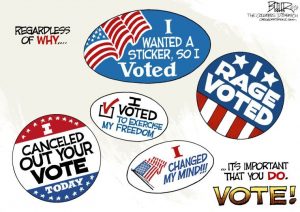
In a typical presidential election year, about 60% of the voting-age population votes. See https://www.census.gov/newsroom/blogs/random-samplings/2017/05/voting_in_america.html. The number is about 40% in non-presidential years, when districts elect their representatives to congress. A smaller number, lower than 30%, usually participate in primary elections, which have a disproportionate effect on the final outcome of elections at all levels (few congressional races are seriously contested in the general elections, and in recent presidential elections where the incumbent was not a candidate the primary elections have produced surprises both in terms of their winners and their policy positions).
Younger people are less likely to vote than older people, and minorities are less likely to vote than non-minorities. This is often used to make an argument that many potential voters feel left out of the democratic process.
The proportion of voter turnout in different categories shifted fairly significantly in the elections between 2008 and 2016, with higher percentages of non-Hispanic blacks voting when Obama was running and higher percentages of non-Hispanic whites voting when Trump was running. Given the relatively small percentages of votes that have swung recent elections, combined with identity politics (where voters of a particular region, ethnic or religious group overwhelming favor one candidate or another), fluctuations have a significant influence on elections and thus on campaigns. For many years a big part of running any campaign is to motivate voters to come to the polls to vote for your candidate while not motivating as many voters who might vote for the opponent(s).
It is our responsibility as eligible citizens to vote, and to encourage others to vote, regardless of whether we agree or disagree with them. It is also our responsibility to participate knowledgeably in the electoral process. We may not always like the outcome, but it is virtually certain that a higher percentage of informed voters will lead to a higher percentage of satisfied citizens and ultimately to more effective government.
